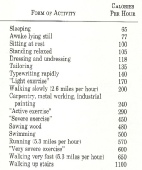
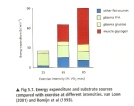
Muscle cells use ATP (Adenosine Triphosphate) molecules as the source of energy for muscle work.
Complex enzymes action use oxygen to release energy from ATP. This is the most efficient energy source for normal activity / exercise.
Anaerobic exercise occurs when oxygen is not available - during very intense exercise - to release enough energy for the muscles to work. The body will use anaerobic means to produce the additional energy to keep up with demand. This is not as efficient as aerobic exercise.
Sustained intense exercise will lead to fatigue due to lack of ATP once its used up. Eventually the exercise intensity cannot be sustained and reduces - allowing the various energy systems to meet the demand. This is often called ‘getting your second wind’
Immediately energy demand is met using a phosphocreatine system but this is very short lived (lasts only seconds).
Energy is then progressively released from the anaerobic and then the aerobic system, with the latter being the most efficient at producing energy over a prolonged period of exercises.
Many people have good intentions to “get fit”. There are many types of ‘fitness’.
To achieve your goals you must be reasonable, practical and honest in your expectations - given your personality and your circumstances. You goals will guide what you need to do.
Improving general fitness, losing weight, increasing strength, endurance, flexibility or merely ‘toning up’ all require different approaches.
The effort needs to be sustained over months, rather than weeks, and will require significant personal time, effort and lifestyle change.
Physiological changes with increased fitness will occur slowly, especially if they are to be maintained, and will reverse if the training is not maintained.
General Fitness + Weight Loss
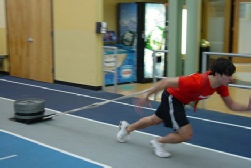


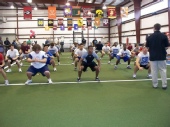
The following are some points worth noting
- High Protein Intake: Diet alone will not increase muscle mass.
- Powdered Protein drinks are proposed as an essential component of bulking up muscle mass. They are not needed for most peoples needs.
- Many people ingest excessive protein for the training they are doing. There is no evidence of any benefit for this.
- Excessive intake of Protein
- is likely to get stored as fat!
- may inhibit intake of carbohydrate.
- can cause increase risk of dehydration, calcium loss and conditions such as gout.
- There is no evidence to support Amino Acid Supplementation for increasing muscle strength.
- Use of substances banned in sports (anabolic steroids, hormone based substances) on their own have no benefit in increasing strength or in bulking up. There are significant health risks associated with their use
Some people, especially young sportspeople are encouraged to gain weight in order to perform optimally in their sport. Diet alone will not increase muscle mass. To increase muscle mass requires combining correct diet (protein along with appropriate carbohydrate intake) with suitable strength training, rest + recovery.
A high protein intake of 150-200% of the normal Recommended Daily Intake (RDI) is often recommended for those attempting to increase body weight.
For most people sufficient dietary protein can be provided from within a normal balanced diet.
A slow gradual loss of weight is more likely to permanently remove body fat. The will be maintained only if the diet + lifestyle changes are made permanent – eating less, more balances diet, exercise regularly etc.
Guidance for losing weight should include the following;
- Reduce calorie intake - substitution / reduce
- Limit Fat intake in the diet
- Avoid ‘hidden’ fats
- Use Dietary Fibre to replace fatty foods.
- Plan your eating and consider the timing of your meals
- Spread the total daily intake evenly through the day.
- Provide appropriate ‘fuel’ for training + for recovery.
- Improving kitchen skills (!)
- Managing your fluid intake -Dehydration impair performance.
- Soft drinks and alcohol should be minimised
- Sports energy drinks are not necessary unless prolonged exercise (2-3 hours +) – plain water is perfectly adequate!
- Sports energy drinks and bars should be avoided - except to provide rapid energy for recovery.
If your resolve does break - don’t worry, simply gather yourself and get back on programme as quickly as possible.
Changes in your metabolic system occur slowly so an occasional slip up will not cause too much harm.
Allow for times when you may veer off programme - Christmas, weddings, your birthday etc - and enjoy them. Use as much restraint as possible and get back on track as soon as possible.
Weight loss should be achieved by a combination of dietary change, exercise and the use of weight loss aids where advisable (saunas etc).
Rapid weight loss is often accompanied by loss of
- Glycogen,
- Water and
- Lean muscle mass
So while weight is indeed lost, little or no body fat is lost.
This approach is also associated with fatigue, low energy levels and poor recovery between training sessions.
It takes more effort to gain fitness than maintain fitness. You can retain improvement even if you reduce the intensity, frequency and duration of training a little. However if you reduce the intensity over a prolonged time the improvement will be gradually lost.
Therefore by increasing the duration / distance covered / intensity of activity during training sessions you can improve general fitness.
General fitness often refers to cardiorespiratory fitness - how effectively the body absorbs O2, transports it to the muscles, extracts it from the blood and uses it in the muscle.
Working at an increased activity intensity will cause the system to adapt and become more efficient i.e. improved fitness.
Body weight will remain static if the energy/fuel (food) taken in by the body equals the fuel burned during daily activity.
If the fuel taken in exceeds what's needed the body stores the excess as fat causing weight gain!!
If the fuel taken in is not sufficient to meet the demand for the day then some fat will be burned instead – leading to weight loss.
Therefore to maintain weight (loss) one must maintain increased exercise levels or reduce food intake as appropriate.
Metabolic Rate refers to the amount of fuel that our body burns even when at rest. Metabolic rate can vary and will change slowly in response to a number of factors.
Activity level is an important determining factor. Increased physical activity will raise the base metabolic rate and the opposite happens with prolonged relative inactivity. To Top
Exercise at an intensity equivalent to 65% of VO2max (60-70 max heart rate) will utilise the most energy from fat.
If weight loss is the aim of the exercise programme then exercise at this intensity, sustained over an appropriate period of time is essential to be effective - more than 45 min).
Acidity within the muscle increases with intensity of exercise. Lactic Acid is produced within the muscle with intense exercise.
Normal PH level within muscle is approx 7.1.
After an initial drop in acidity, at lower + moderate intensities of exercise the amount of lactic acid produced = removal, so muscle acidity remains the same.
At higher intensities the production of lactic acid exceeds the amount being removed and acidity within the muscle and blood increases. Increased lactic acid within the muscle leads to soreness and stiffness/
Low intensity exercise done as a ‘Warm Down’ reduces the levels of lactic acid (lactate) in the muscles cells and bloodstream to pre exercise levels. The amount of ‘Warm Down’ needed varies for each individual after training.
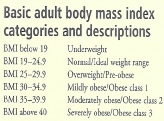
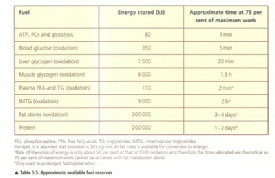

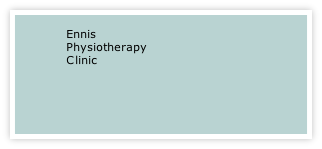




Mon - Fri 9.30am - 8.30pm


3A Barrack Close, Barrack St., Ennis, Co. Clare V95 X437

065 6840757
| Health+Safety Services |
| Sports Clubs+Teams Services |
| Standing Posture |
| Sitting Posture |
| Childhood Posture |
| Using Portable Devices |
| Normal Walking |
| Running |
| Running Drills Videos |
| Muscle Energetics |
| General Fitness |
| Losing Body Weight |
| Gaining Body Weight |
| Weight Loss Programmes |
| Start to Run |
| Start to Swim |
| Start Cycling |
| Start Nordic Waliking |
| Rehab of Tensdons |
| Loading of Tendons |
| Non Specific LBP |
| Posture |
| Intervertebral Disc |
| LBP Treatment |
| Non Specific Neck Pain |
| Neck Care Advice |
| Hamstring Strain |
| Ankle Sprain |
| ACL Injury |
| Joint Replacement |
| Shoulder Dislocation |
| Tennis Elbow |
| Wrist fracture |
| Fractured Knuckle |
| Selecting a Racquet |
| Racquet Grip Size |
| Racuet Sport Injuries |
| Training for Racquet Sports |
| Ski + Board Injuries |
| Injury Videos |
| Injury Prevention |
| Preventing Injury in Musicians |
| Irish Dancing |
| Preventing Dance Injury |